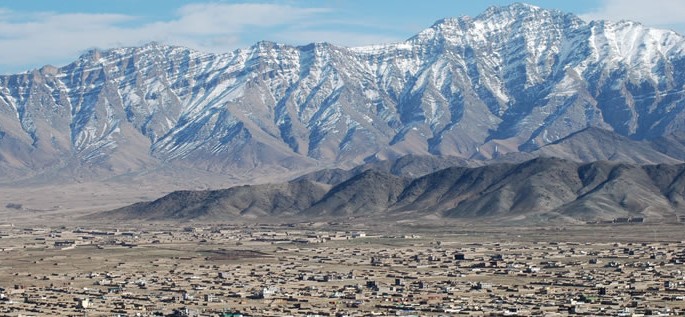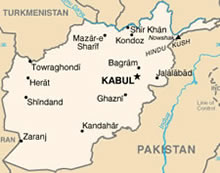
Dari
Dari, also known as Afghan Persian, East Farsi, and Eastern Persian, is a member of the Indo-Iranian branch of the Indo-European language family. It is spoken by 7.6 million people in Afghanistan. Various dialects of Dari are also spoken by some 15,000 people in Iran (including Zoroastrian Dari), and by 1 million people in Pakistan, as well as in emigré communities in the Middle East, Europe, Canada, and the U.S. The total number of Dari speakers around the world is estimated to be around 9.6 million (Ethnologue).
Status
Dari is the national language of Afghanistan, along with Pashto. It serves as a lingua franca among speakers of the many different languages of the country. Dari is taught in schools, used in the media, and in government administration. In Iran, Dari, is not written or taught in schools. There are 1 million Dari speakers, many of them refugees of the war, in Pakistan where the language has no official status.
Click on the MLA Interactive Language Map to find out where Persian (all dialects) is spoken in the U.S.
Dialects
Dari has a number of dialects, most of which are mutually intelligible:
Radio Afghanistan broadcasts are promoting a standardized pronunciation of the literary language based on classical norms. Formal Dari speech is closer to Standard Western Persian (Farsi) of Iran, while informal speech in some parts of Afghanistan is closer to Tajik of Tajikistan.
Structure
Sound system
The sound system of Dari differs somewhat from that of Contemporary Standard Persian, possibly due to the influence of surrounding Turkic languages.
Vowels
Dari has seven vowel phonemes which are given below. The vowels /e/ and /o/ have long counterparts. Vowel length makes a difference in word meaning. Dari has two diphthongs, /ai/ and /au/, which have no counterparts in Western Persian.
| Close |
i
|
u
|
|
| Mid-close |
e, ē
|
o, ō
|
|
| Open |
a
|
Consonants
The consonant inventory of Dari may vary somewhat, depending on the dialect.
| Stops | voiceless |
p
|
t
|
k
|
q
|
ʔ
|
|||
| voiced |
b
|
d
|
g
|
||||||
| Fricatives | voiceless |
f
|
s
|
ʃ
|
x
|
h
|
|||
| voiced |
v
|
z
|
ʒ
|
||||||
| Affricate | voiceless |
tʃ
|
|||||||
| voiced |
dʒ
|
||||||||
| Nasal |
m
|
n.
|
|||||||
| Lateral |
l
|
||||||||
| Trill |
r
|
||||||||
| Glide |
j
|
- /q/ has no equivalent in English
- /ʔ/ = sound between syllables in uh-oh
- /x/ has no equivalent in English, it is similar to ch in Loch
- /ʃ/ =sh in shape
- /ʒ/ = s in measure;
- /tʃ/ = ch in chat
- /dʒ/ = j in jet
- /j/ = y in yet
Stress
Stress typically falls on the last syllable of the root.
Grammar
The grammatical systems of Dari (Eastern Persian) and Farsi (Western Persian) do not differ in any significant way. The description below covers the main grammar points of both languages. Both Dari and Farsi are inflected languages, i.e., they add suffixes to roots to express grammatical relations and to form words. Unlike many other Indo-Iranian languages, Dari and Farsi have lost most of their noun and verb inflections.
Nouns
- Nouns can be simple or compound.
- Any unmodified noun may be generic, i.e., refer to one or more than one items. Plural is not obligatory. The marker –hā signals plural with count nouns, e.g., ketāb-hā ‘books’, and amplification with mass nouns, e.g., āb-hā ‘all kinds of water, lots of water’. Human nouns take –ān, while nouns borrowed from Arabic usually take -in.
- There is no grammatical gender.
- There is a distinction between genericity and indefiniteness which applies to both count and mass nouns. It is expressed by the suffix –i, e.g.,ketāb-i ‘some/a book’, ketāb-hā ‘some books’.
- Definiteness is not marked formally.
- Possession is marked by the suffix –e, e.g., ketāb-e Ali ‘the book of Ali’.
- Topicalization is marked by the suffix –ra, e.g., be man ketāb-ra Hasan ‘as for the book, he gave it to Hasan’.
Verbs
Verbs are marked for the following categories:
- There are three persons: first, second, and third.
- There are two numbers: singular, and plural.
- There are three moods: indicative, subjunctive, counterfactual subjunctive.
- There are two aspects: imperfective and perfective. Aspect is as important as tense.
- There are three tenses: present, past, and inferential past. Inferential past expresses second-hand knowledge, information, or conclusions. Future is not a tense but a modality (similar to the English want to/wanna + infinitive). All present and past forms may be used in a future context.
- Causality is marked by the suffix –ān, e.g., xor ‘to eat’ — xorān ‘to feed’.
- Subject pronouns are usually dropped since the verb form itself carries information about person and number.
Word order
The normal word order is Subject-Object-Verb. Modifiers follow the nouns they modify.
Vocabulary
Dari frequently uses derivational affixes to form new words from nouns, adjectives, and verbal stems. New words are also formed by compounding, i.e., by combining two existing words into one. Dari also has a large number of Farsi and Arabic loan words which are more prevalent in the written than in the spoken language. Pashto and Tajik words have also been introduced into the language. Most recently, there have been a number of borrowings from English.
Below are a few common Dari phrases and words in Latin transliteration.
| Hello | Salām |
| Peace be with you | Salām aleikom |
| Good bye | Xodāfez |
| Please | Loftān |
| Thank you | Tashakkor |
| Good willing | Enshā allāh |
| Excuse me | Bebaxshīd, |
| Yes | Balé |
| No | Naxeir, na |
| Man | Mard |
| Woman | Zan |
Below are the Dari numerals 0-10.
|
0
|
1
|
2
|
3
|
4
|
5
|
6
|
7
|
8
|
9
|
10
|
|---|---|---|---|---|---|---|---|---|---|---|
|
|
|
|
|
|
|
|
|
|
|
|
|
sefr
|
yek
|
do
|
se
|
chahār
|
panj
|
shesh
|
haft
|
hasht
|
noh
|
dah
|
Writing
Persian and Dari are written in a modified Arabic script, known as Perso-Arabic. It contains 4 additional letters to represent Persian sounds [p], [ʃ], [ʒ], [g] which are not represented in the Arabic alphabet. The alphabet is consonant-based. Like Arabic, it is written from right to left. Like Arabic, it can also be written in a variety of script forms.
Several attempts were made in the 19th-20th centuries to replace the Perso-Arabic alphabet with Latin-based alphabets.
- The Universal Persian Alphabet (UniPers) is a Latin-based alphabet created over 50 years ago and used in a number of Persian textbooks for foreigners and travelers. It avoids the difficulties of the Perso-Arabic alphabet, with its multiple letter shapes and ambiguous spellings, and lends itself well to computer keyboards.
- The International Persian Alphabet (Parsik) is another Latin-based alphabet developed in recent years as a project of the Persian Linguistics Association. It is claimed to be the most linguistically accurate representation of spoken Persian, however, it is not as simple as UniPers.
- Fingilish, or Penglish, refers to the use of the basic Latin alphabet in electronic communications, such as chat and e-mails.
Take a look Article 1 of the Universal Declaration of Human Rights in the Perso-Arabic script and in Romanization.
[
Did You Know?
English has borrowed a number of words from Persian which, in turn, had borrowed from Arabic. Most of them came into English indirectly through other languages, mostly French and Greek. A few of these loanwords are listed below:
|
English borrowing
|
from Persian
|
|---|---|
| baksheesh | bakhshish, literally ‘gift’ |
| bazaar | bazar ‘market’ |
| caravan | picked up in the Crusades from Persian karwan ‘group of desert travelers’ |
| caviar | khaviyar, from khaya ‘egg’ + dar ‘bearing’ |
| lac | lak ‘resinous substance’ |
| magic | Old Persian magush ‘magician’ |
| mummy | mumiya, from mum ‘wax’ |
| pilaf | pilaw, ‘rice dish with meat |
| pistachio | pista ‘pistachio tree’ |
| shah | shah, title of king of Persia |
| scarlet | saqirlat, a kind of rich cloth, not necessarily red |
| seersucker | shir-o-shakkar ‘striped cloth,’ literally ‘milk and sugar,’ an allusion to the alternately smooth and puckered surfaces of the stripes, from shir ‘milk’ + shakar ‘sugar’ |
| taliban | talib ‘theological student’ + –an ‘animate plural marker’, from Arabic talib ‘to search for, seek’ |
Difficulty
 How difficult is it to learn Dari?
How difficult is it to learn Dari?Dari, Farsi, and Tajik are considered to be Category III languages in terms of difficulty for speakers of English.

